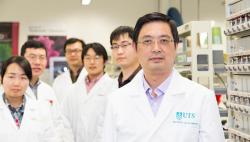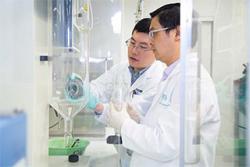The CCET research team is powering ahead with the development of a fast and efficient Lithium-oxygen (Li-O₂) battery system with the recent publication of research results in the journal of Angewandte Chemie International Edition.

Miss. Lin Liu, Dr. Bing Sun, Dr. Dawei, Dr. Sinho Choi, Mr. Jinqiang Zhang, Prof Guoxiu Wang
As the demand for energy storage technologies escalates, new battery systems are being developed and Lithium-oxygen batteries have great potential - the direct reaction of oxygen from the atmosphere and lithium ion in the electrolyte of the battery can release amounts of energy 10-fold higher than current commercial lithium-ion batteries. However drawbacks remain, for example the relatively low conductivity of the main discharge product lithium peroxide (Li2O2) often results in a very high charge potential which induces numerous side-reactions, leading to low efficiency and shortened battery life.
To overcome these issues the CCET team has been working on improving the performance of solution-based catalysts, called redox mediators - these have been shown to be superior to more traditional solid-state catalysts but come with their own set of issues.
“Unfortunately you end up with a lot of corrosion on the lithium anode, “ lead author and UTS CCET PhD candidate Jinqiang Zhang says.

Dr. Bing Sun and professor Guoxiu Wang.
Image by Vanessa Valenzuela-Davie.
“However we discovered that when you add lithium chloride to the redox mediator, TTF, or tetrathiafulvalene, magic happens. Adding a ‘pinch of salt’ converts the solution based catalyst to a solid conductive compound that deposits on the entire surface of the cathode,” he says.
The result is an economical way to produce a more efficient battery with a prolonged life cycle. Next steps for this research are to figure out more suitable electrolyte solvents to enhance the overall stability environment for these battery reactions.
The last few months have been especially productive for CCET with a number of publications in high ranking journals. CCET Director Distinguished Professor Guoxiu Wang said that the review of rechargeable lithium battery technology published in Advanced Energy Materials showed that the development of new materials and technologies was crucial to developing rechargeable lithium batteries suitable for Electric Vehicle (EV) battery storage.
“Rechargeable batteries are widely considered as the best power sources for the next generation large scale energy storage systems for EVs, to replace non-renewable energy sources” Prof Wang says.
Rechargeable batteries are widely considered as the best power sources for the next generation large scale energy storage systems for EVs, to replace non-renewable energy sources
“However while rechargeable lithium batteries have revolutionised portable electric devices, such as laptops, their use in EVs or HEVs requires high power batteries that operate under high current conditions.”
The review summarises the research progress on porous carbon composites, - seen as a potential game –changer for lithium battery storage – and outlines the challenges for commercialisation.
The CCET has also recently published a number of articles in Advanced Materials on Lithium-Sulphur batteries and the development of high-performance Na–O2 batteries. The CCET’s continued research focus is the development of novel functional materials, with high efficiencies, which will lead to improvements in a wide range of energy storage devices for a sustainable future.
Funding:
Automotive Australia 2020 Cooperative Research Centre, ARC Discovery, DECRA and Future Fellowship programs, Australian Renewable Energy Agency (ARENA), The Rail Manufacturing CRC.
Publication details:
Zhang, J., Sun, B., Zhao, Y., Kretschmer, K. & Wang, G. 2017, 'Modified Tetrathiafulvalene as an Organic Conductor for Improving Performances of Li-O2 Batteries', Angewandte Chemie International Edition, vol. 56, no. 29, pp. 8505-8509.
http://onlinelibrary.wiley.com/doi/10.1002/anie.201703784/full
Liu, H., Liu, X., Li, W., Guo, X., Wang, Y., Wang, G. & Zhao, D. 2017, 'Porous Carbon Composites for Next Generation Rechargeable Lithium Batteries', Advanced Energy Materials http://onlinelibrary.wiley.com/doi/10.1002/aenm.201700283/full
Su, D., Cortie, M., Fan, H., Wang G. 2017, ‘Prussian Blue Nanocubes with an Open Framework Structure Coated with PEDOT as High-Capacity Cathodes for Lithium–Sulfur Batteries’, Advanced Materials. http://onlinelibrary.wiley.com/doi/10.1002/adma.201700587/full
Sun B., Kretschmer K., Xie X., Munroe P., Peng Z., Wang G. 2017, ‘Hierarchical Porous Carbon Spheres for High-Performance Na–O2 Batteries’, Advanced Materials. http://onlinelibrary.wiley.com/doi/10.1002/adma.201606816/full
Meng-Qiang Zhao, Xiuqiang Xie, Chang E. Ren, Taron Makaryan, Babak Anasori, Guoxiu Wang, Yury Gogotsi 2017, “Hollow MXene Spheres and 3D Macroporous MXene Frameworks for Na-Ion Storage” Advanced Materials
http://onlinelibrary.wiley.com/doi/10.1002/adma.201702410/full

